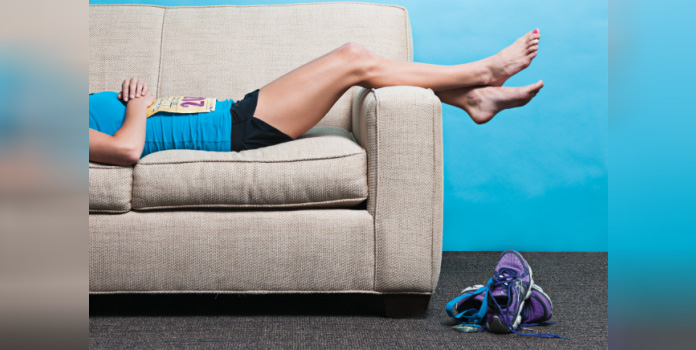
Running Tips – Running is perhaps the easiest activity which you can do to get fit. You do not need any equipment for running apart from a quality pair of running shoes. There is no particular need for a specialized training like that in yoga or swimming. No wonder we see a significant number of public marathons in which a huge number of people participate these days.
Related: Benefits of Running.
However, you will be astonished to know that running is also one of the most injury-prone activities. Some studies even estimate the number of runners getting injured per year at a staggering 74%. And this is something mind-boggling as we think that everyone knows how to run. Right?
Wrong! The truth is everyone does not know how to run “properly.” Given the enormous number of runners getting injured and so many people quitting running after some time due to pain and injuries, running has earned a much negative reputation among ordinary citizens. This is mainly due to lack of right information about proper techniques and rules of running.
Read and follow these 23 basic Running Tips spread across 4 fundamental areas of running- Preparation, Form, Nutrition, and Recovery.
Beginner running tips for preparation
Contents
- 1 1. Invest in Quality Pair of Running Shoes
- 2 2. Change Your Running Shoes After Every 300-400 Miles
- 3 3. Warm Up Before Running
- 4 4. Slow and Steady Wins The Race – Start Small
- 5 5. Do Not Ignore Strength Training
- 6 6. Stay Hydrated
- 7 7. Upright Body & Relaxed Shoulders
- 8 8. Slightly Lean Your Body Forwards While Keeping A Straight Back
- 9 9. Increase The Number of Steps
- 10 10. Avoid Hitting Ground on Your Heels
- 11 11. Breath Properly to Run Efficiently
- 12 12. Have A Gap
- 13 13. Fuel Your Body Before Running
- 14 14. Do Not Ignore Post Running Nutrition
- 15 15. Never Underestimate The Healing Power
- 16 16. Beware of Overtraining
- 17 17. Always Stretch After A Run to Prevent Stiff Legs
- 18 18. Aim For Having A Good Night Sleep
- 19 19. No Pain No Gain
- 20 20. Set Goals and Create A Plan
- 21 21. Never Give Up
- 22 22. Spice Up Your Running Routine.
- 23 23. Use Interval Training
1. Invest in Quality Pair of Running Shoes
The difference between a good and bad quality of shoes could result in a difference between a successful run and injury. And you would not want an injury to ruin your plans of getting fit by running.
So, visit a renowned store where you can get recommendations for a good pair of running shoes. Some of the specialist shops recommend shoes after accurately analyzing your basic running form, foot striking patterns, and the trails. You can also learn about how to select specialized running shoes by reading this article.
2. Change Your Running Shoes After Every 300-400 Miles
This is critical in the long term as soles of your running shoes undergo a significant wear and tear. And if you continue running in those shoes, you can get your feet hurt due to an increase in impact. This can lead to serious injuries and put a rest to your running plans.
3. Warm Up Before Running
Warming up is an age old classic advice but is often ignored the most. It is crucial to warm up your body as it increases the temperature and blood flow to muscles. Always start you run with a light jog for 5-10 minutes.
You can also do a few jumping jacks and dynamic stretching exercises (leg swings, hip extension exercises) to get ready for the run. However, do not do excessive static stretching exercises before the run as it leads to poor running efficiency and sometimes even injuries.
4. Slow and Steady Wins The Race – Start Small
This cannot be stressed too much for a beginner runner. You are not going to become Usain Bolt within a month or even a year if you have not run before. It is always the best to take it very slowly.
In fact, begin with a walking routine if you are a total beginner to running. After some time, move to brisk walking and then jogging at a slower pace. The idea is not to overload your cardiovascular system and gradually increasing its capacity.
5. Do Not Ignore Strength Training
Many runners make this mistake of focusing only on running and ignoring other exercises. Runners do not need to do strength training is perhaps the most widespread misconception in the fitness community.
Although you will be able to increase your speed and distance of runs over time but if you are not getting stronger, you are posing yourself to a high risk of injury.
6. Stay Hydrated
Your body loses large amounts of fluids when you do any exercise. And when you run, it loses more fluids. So it is imperative to drink water at regular intervals throughout the day to stay hydrated.
You should aim to drink about 20 oz. (almost 600 ml) water about a couple of hours before you go running. This allows your body system to get completely hydrated before running.
Essential running tips for proper form
7. Upright Body & Relaxed Shoulders
Imagine a string over the top of your head pulling your head upwards while running. Too many people slouch or tilt their necks while running which is a poor form of running. Keep the body in a straight line with relaxed shoulders. Also, pay attention to the grip of your hands and avoid it to be too tight.
Quick running tip : Place your thumb inside your fist instead of regular clinching to relax forearms and shoulders while running.
8. Slightly Lean Your Body Forwards While Keeping A Straight Back
This is somewhat tricky one for beginner runners. If you observe professional runners, there is a slight forward tilt in their body when they are running. This helps them to make use of gravity to propel them naturally forward without exerting excessive force on legs.
9. Increase The Number of Steps
The number of steps per unit distance is often called as cadence. Often beginner and experienced runners make the mistake of taking long steps while running. This not only causes the foot to strike on heels (cause of injury) but also increase the impact with the ground.
Short and quick steps ensure that you are hitting the ground on foot middle and exactly beneath the body. This reduces the chance of injuries.
10. Avoid Hitting Ground on Your Heels
Striking on heels is the most common cause of running injuries. This puts a severe strain on ankles and joints which could lead to serious injuries in future. Aim to strike the ground with front or middle foot directly beneath your hips. If you follow the above tip in this section, it will happen naturally.
11. Breath Properly to Run Efficiently
Proper breathing is one of the most important running tips which you can implement. Many runners often breath irregularly while running whereas long distance runners often breath too much. The key is to maintain a regular rate of breathing throughout your running. Always match your strides to the rate of breathing and not the other way round.
Nutrition tips for running
12. Have A Gap
Food takes time to get digested. If you immediately go on a run after the meal, the food will not be able to provide any energy to you, and you may end up vomiting in the end. Try to keep 1-2 hour gap between your meal and a run.
13. Fuel Your Body Before Running
Running requires energy and carbohydrates provide energy. If you are taking a meal more than 90 minutes before the run, go for complex carbs and little protein. Complex carbs release slowly into your body and give energy at the time of running.
However, if you have less time for run and need to eat something, go for a banana or dried nuts which will give you an instant release of energy for running.
14. Do Not Ignore Post Running Nutrition
After the run, it is important to refuel the body within 30-45 minutes as it is the ideal time for getting all nutrients absorbed in the body. Aim for a carb to protein ratio of 4:1. Do not avoid protein as it helps to build the muscles and tissues damaged during exercise.
Rest and recovery for better running
15. Never Underestimate The Healing Power
Running takes a significant toll on your body. That is why it is one of the most effective exercises to lose weight and get fit if you do it properly. However, it is important to give proper rest and breaks to body in between long distance runs.
During rest days, you can do cross training such as Yoga, swimming or upper body exercises to develop strength.
16. Beware of Overtraining
This naturally follows from the above running tip. Any exercise damages muscles in the body and only when we give them time to recover, we become stronger and healthier. But, if you continue to train without any time for recovery, you run a risk of overtraining putting yourself at a risk of serious injuries.
17. Always Stretch After A Run to Prevent Stiff Legs
Do not stop abruptly from a run and step outside your running shoes. Gradually end the run with a slow jog for 5-10 minutes to cool down the body. After that, stretch your leg muscles for 5-7 minutes to prevent them from getting stiff and sore.
Quick Tip : After running and stretching, raise your legs against a wall while laying down over your back. This allows blood to move away from legs and fresh blood is circulated when you again stand up. You will experience immense relief from this technique called as “leg drain” without any painful stiffness later.
18. Aim For Having A Good Night Sleep
A proper night sleep of 7-8 hours is necessary for repair and recovery of body muscles. It ensures that your body is fresh for the morning run. Sleep is the nature’s way to heal our body. Make use of it.
Related: How to Sleep Better.
19. No Pain No Gain
Pay utmost attention to your body signals. If pain exists for more than two days, immediately consult a medical professional to get yourself checked for any injuries. There is a thin line between post-running soreness and injury related stabbing pain. Learn to identify that to protect yourself from injuries.
Bonus yet extremely useful running tips
20. Set Goals and Create A Plan
Benjamin Franklin once said that people who fail to plan are planning to fail. This is true for running as well. If you are a beginner in running, set reasonable weekly and monthly goal of running. Set a time frame in which keep yourself accountable for daily progress you make to achieve that goal.
21. Never Give Up
People who have never run before often find running too hard. Many people often quit in between as they feel too tired and exhausted for rest of the day after running. Be patient to allow your body to adjust slowly to the physical demands of running.
You will soon discover that you can not only run faster and longer distances but also feel fresh and alive after running. So, never give up.
22. Spice Up Your Running Routine.
Your body gets quickly adapted if you continue doing similar set of exercises. Moreover, after a point of time, you could also feel bored doing same exercises or running along similar routes.
So add some spice by changing your pace of running, running on a different track, incorporating few pushups in between runs, doing sideway running- the possibilities are endless.
23. Use Interval Training
This running tip should be only followed by people who have become used to running short distances. Sprint for 20 seconds and then do a light jog for 10 seconds. Repeat the sequence for 3-5 times as per your convenience.
You can further vary the duration and gap between intervals. Interval training in this manner improves efficiency of your cardiovascular system and ultimately helps in better running.
Running may seem like a natural thing but like any other exercise, running also needs proper form and technique to gain maximum benefits and prevent injuries.
The above running tips will help you in improving your running and hence, your fitness levels by leaps and bounds.
Also Read : You Can Get Fit And Have Fun With This Exercise Approach




